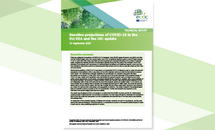Baseline projections of COVID-19 in the EU/EEA and the UK: update
This report provides updated 30-day projections, together with the inherent model assumptions and uncertainties. Both the model projections and the data to which the model is calibrated should be interpreted with caution given the differences between national surveillance systems, case definitions and testing policies. Comparisons between countries based on the data and forecasts presented in this paper should only be made with extreme caution and should take these differences into account. Nonetheless, the projections presented here illustrate potential future trends in COVID-19 transmission in EU/EEA countries and the UK.
Executive Summary
Following widespread transmission of SARS-CoV-2 in European Union (EU)/European Economic Area (EEA) countries and the United Kingdom (UK) over several weeks, the COVID-19 epidemic reached a peak in most of these countries in April or early May 2020. Some countries have since experienced a sustained decrease in the number of reported cases, progressively reaching the level of transmission reported during the first week of the outbreak. Due to this decrease in transmission and improvements in epidemiological surveillance and healthcare capacity, some countries have decided to discontinue several non-pharmaceutical interventions and now plan to gradually phase out their ‘stay-at-home’ policies.
Mathematical modelling of SARS-CoV-2 transmission and associated COVID-19 disease is used to assess the potential progression of the epidemic within a population and to inform decision-making on potential interventions to ensure public health. The methodology inherently facilitates the quantification of uncertainty associated with these estimations and projections. In May 2020, ECDC produced a set of short-term forecasts of the expected number of COVID-19 cases, deaths and hospitalised cases (subdivided into general hospital wards and intensive care units), under a set of assumptions. In this report, we present updated 30-day projections, together with a visual validation of the original forecasts. We continue to model a baseline ‘status quo’ scenario, assuming all control measures in place on 8 September 2020 will be continued until the end of the projection period (14 October 2020). In this version, we have included data on testing rates to simulate the increased ascertainment of milder cases. For almost all countries, testing data is correct until 23 August. We have also included the use of face masks (both mandatory and voluntary) as a means for reducing both transmission and susceptibility to infection. The model is based on the epidemiological data and scientific evidence available at the time of publication. Further developments are expected as new information and epidemiological data become available.
The model was developed at ECDC and applied at a national level for EU/EEA countries and the UK. Mathematical models provide a helpful approach for quantifying uncertainty, but their output should be interpreted and appraised in light of both the underlying assumptions and the completeness and potential bias of the data used to parameterise and calibrate them.
An assessment of the potential trajectory of disease and mortality caused by the COVID-19 pandemic, and the most appropriate response strategies, should be based on a comprehensive analysis of the specific epidemiological situation in each country, using modelling projections in context.
Download

Read more
Public health guidance
Updated projections of COVID-19 in the EU/EEA and the UK
In May 2020, ECDC produced a set of short-term forecasts of the expected number of COVID-19 cases, deaths and hospitalised cases (subdivided into general hospital wards and intensive care units). Updated forecasts were published in September 2020. In this report we present slightly longer-term projections for each country, up until 25 December 2020.




